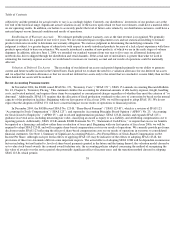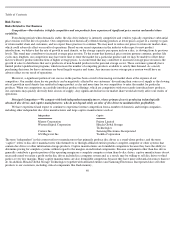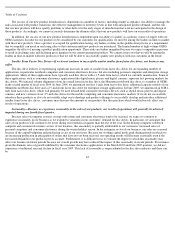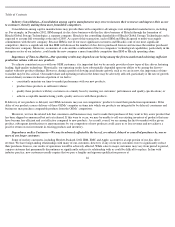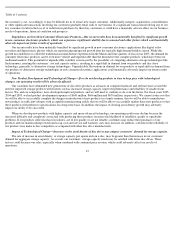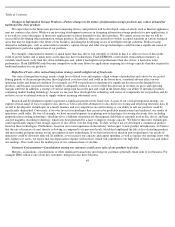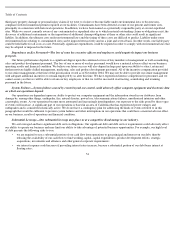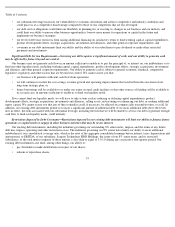Seagate 2004 Annual Report Download - page 49
Download and view the complete annual report
Please find page 49 of the 2004 Seagate annual report below. You can navigate through the pages in the report by either clicking on the pages listed below, or by using the keyword search tool below to find specific information within the annual report.
Table of Contents
Industry Consolidation—Consolidation among captive manufacturers may serve to increase their resources and improve their access
to customers, thereby making them more formidable competitors.
Consolidation among captive manufacturers may provide them with competitive advantages over independent manufacturers, including
us. For example, in December 2002, IBM merged its disc drive business with the disc drive business of Hitachi through the formation of
Hitachi Global Storage Technologies, a separate company. Hitachi is the controlling shareholder of Hitachi Global Storage Technologies and is
expected to assume full ownership at the end of 2005. As a part of this transaction, each of IBM and Hitachi agreed to multi-year supply
commitments with the new company. Because IBM is one of our most significant customers and Hitachi is one of our most significant
competitors, there is a significant risk that IBM will decrease the number of disc drives purchased from us and increase the number purchased
from the new company. Moreover, economies of scale and the combination of the two companies’
technological capabilities, particularly in the
enterprise sector of our industry, could make the new company a more formidable competitor than IBM or Hitachi operating alone.
Importance of Time-to-Market—Our operating results may depend on our being among the first-to-market and achieving sufficient
production volume with our new products.
To achieve consistent success with our OEM customers, it is important that we be an early provider of new types of disc drives featuring
leading, high-quality technology. Historically, our operating results have substantially depended upon our ability to be among the first-to-
market with new product offerings. However, during a period of slowing areal density growth, such as we are in now, the importance of time-
to-market may be less critical. Our market share and operating results in the future may be adversely affected, particularly if the rate of growth
in areal density resumes its historical pattern, if we fail to:
•
consistently maintain our time-to-market performance with our new products;
•
produce these products in sufficient volume;
•
qualify these products with key customers on a timely basis by meeting our customers’ performance and quality specifications; or
If delivery of our products is delayed, our OEM customers may use our competitors’ products to meet their production requirements. If the
delay of our products causes delivery of those OEMs’ computer systems into which our products are integrated to be delayed, consumers and
businesses may purchase comparable products from the OEMs’ competitors.
Moreover, we face the related risk that consumers and businesses may wait to make their purchases if they want to buy a new product that
has been shipped or announced but not yet released. If this were to occur, we may be unable to sell our existing inventory of products that may
have become less efficient and cost effective compared to new products. As a result, even if we are among the first-to-market with a given
product, subsequent introductions or announcements by our competitors of new products could cause us to lose revenue and not achieve a
positive return on our investment in existing products and inventory.
Dependence on Key Customers—We may be adversely affected by the loss of, or reduced, delayed or cancelled purchases by, one or
more of our larger customers.
•
achieve acceptable manufacturing yields, quality and costs with these products.
Some of our key customers, including Hewlett-Packard, Dell, IBM, EMC and Apple, account for a large portion of our disc drive
revenue. We have longstanding relationships with many of our customers, however, if any of our key customers were to significantly reduce
their purchases from us, our results of operations would be adversely affected. While sales to major customers may vary from period to period,
a major customer that permanently discontinues or significantly reduces its relationship with us could be difficult to replace. In line with
industry practice, new customers usually require that we pass a lengthy and rigorous qualification process at
46




